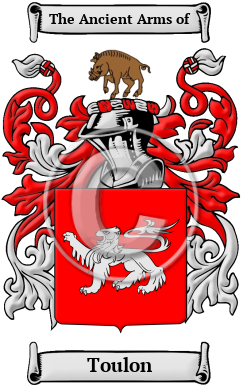| ![Show Contents]() Toulon History, Family Crest & Coats of Arms Toulon History, Family Crest & Coats of Arms
- Origins Available:
Ireland
Etymology of ToulonWhat does the name Toulon mean? Throughout history, very few Irish surnames have exclusively maintained their original forms. Before being translated into English, Toulon appeared as Ó Tuathail, which is derived from "tuathal," which means "people mighty." Early Origins of the Toulon familyThe surname Toulon was first found in County Kildare (Irish:Cill Dara), ancient homeland of the Kildare based Uí Dúnlainge (Kings of Leinster), located in the Province of Leinster, seated at O'Toole's Castle, where they were descended from Tuathal, King of Leinster who died in 950 A.D. Early History of the Toulon familyThis web page shows only a small excerpt of our Toulon research. Another 102 words (7 lines of text) covering the years 1128, 1180, 1225, 1327, 1590, 1670 and 1722 are included under the topic Early Toulon History in all our PDF Extended History products and printed products wherever possible. Toulon Spelling VariationsPronunciation, rather than spelling, guided scribes and church officials when recording names during the Middle Ages. This practice often resulted in one person's name being recorded under several different spellings. Numerous spelling variations of the surname Toulon are preserved in these old documents. The various spellings of the name that were found include Toole, Tool, O'Toole, O'Tool, Tooley, Toile and many more. Early Notables of the Toulon familySt. Laurence O'Toole; Lorcán Ua Tuathail, also known as St Laurence O'Toole, (1128-1180), Archbishop of Dublin, canonized in 1225 by Pope Honorius III; and Adam Dubh Ó Tuathail, died 1327, was a member of the Ó Tuathail clan...
Another 38 words (3 lines of text) are included under the topic Early Toulon Notables in all our PDF Extended History products and printed products wherever possible.
| Toulon migration to the United States | + |
During the 19th century thousands of impoverished Irish families made the long journey to British North America and the United States. These people were leaving a land that had become beset with poverty, lack of opportunity, and hunger. In North America, they hoped to find land, work, and political and religious freedoms. Although the majority of the immigrants that survived the long sea passage did make these discoveries, it was not without much perseverance and hard work: by the mid-19th century land suitable for agriculture was short supply, especially in British North America, in the east; the work available was generally low paying and physically taxing construction or factory work; and the English stereotypes concerning the Irish, although less frequent and vehement, were, nevertheless, present in the land of freedom, liberty, and equality for all men. The largest influx of Irish settlers occurred with Great Potato Famine during the late 1840s. Research into passenger and immigration lists has brought forth evidence of the early members of the Toulon family in North America:
Toulon Settlers in United States in the 18th Century- Nicholas Toulon, who landed in New York in 1759 1
- Filby, P. William, Meyer, Mary K., Passenger and immigration lists index : a guide to published arrival records of about 500,000 passengers who came to the United States and Canada in the seventeenth, eighteenth, and nineteenth centuries. 1982-1985 Cumulated Supplements in Four Volumes Detroit, Mich. : Gale Research Co., 1985, Print (ISBN 0-8103-1795-8)
 |

